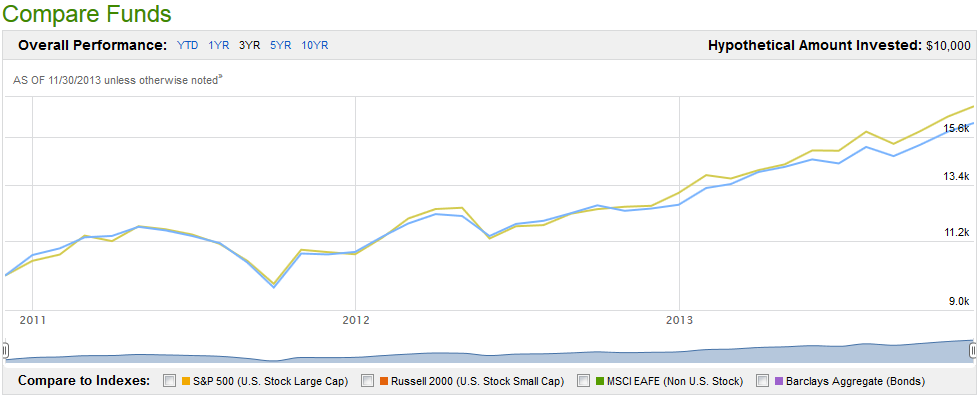There Are Differences Between Index Funds Scott Burns
Post on: 29 Август, 2015 No Comment

by Scott Burns
Share on Facebook Share on Twitter Print Article
Q: I have been looking at two index funds — Vanguard Index 500 and T. Rowe Price Equity Index 500, both of which seek to match the total return of the S&P 500 Index. Both funds have a $10 maintenance fee, similar expense ratios and similar year-to-date returns.
Assuming costs were the same, wouldnt it be better to go with the fund priced at $35 a share (T. Rowe Price), rather than the fund valued at $123 a share? Assuming a $3,600 investment, Id rather have 100 shares at $36 than hold 29.27 shares at $123, but Im not sure why. Are there some advantages to holding the smaller of the two funds? — H.F. Conroe, Texas
A: If you were buying shares of common stock, many would argue that you should buy the lower priced shares (1) for a broader market, and (2) for the round lot commission. Such arguments, however, dont apply here because the share price of a no-load mutual fund is a simple matter of arithmetic (portfolio value divided by number of shares outstanding), nothing else.
Although both funds have low expense ratios relative to actively managed funds, the expense ratios are NOT similar. Vanguard Index 500 is 0.18 percent, while T. Rowe Price Equity Index is 0.40 percent. Thats more than twice as much.
Probably the most important thing to watch — after expenses — is the potential capital gains exposure. Thats the amount of unrealized capital gains in the portfolio. Each of those unrealized gains represents a potential future tax bill if you are holding the fund in a taxable account. (Its irrelevant if you are in a qualified account such as an IRA or SEP.) In this case, the potential capital gains exposure, according to the Morningstar database, is 46 percent in the Vanguard fund and 35 percent in the Price fund.
While there is no way of making a reasonable calculation, some observers would hold that the smaller of the two funds — Price, by far — could have a substantial tax advantage over the larger fund simply due to potential growth from new shareholder investments. Basically, each new shareholder dilutes the capital gains exposure of existing shareholders by putting new, zero-tax liability cash into the fund. It is just that growth that has aided Vanguards widely admired tax efficiency. Now, however, the Vanguard Index fund has $87 billion in assets, compared to the $4.2 billion in the Price fund.
Its doubtful, though, that the potential tax dilution benefit at Price can overcome its additional cost burden. If you look at the figures for both funds (shown in the table below), you can see that Vanguard beat Price before and after taxes over the five-year period ending June 30.
Just for fun, here are the figures for four S&P 500 Index funds. The three no-load funds are pretty close. One Group Equity Index B shares, however, are burdened with a 1.00 percent 12b-1 charge, which brings the total expense ratio to 1.35 percent — three to six TIMES the cost of the three no-load funds. You can read the price of that extra cost burden directly in the performance of the shares. All index funds are NOT the same.
Fund Name�Five-Year Return
(a)�Tax-Adjusted Five-Year Return(a)�Percent Capital Gain Exposure�Expense Ratio��Vanguard Index 500�27.78%�26.68%�46%�0.18%��T. Rowe Price Equity Index�27.51%�26.19%�35%�0.40%��Fidelity Spartan Market Index�27.51%�26.19%�32%�0.19%��One Group Equity Index B �26.21%�25.07%�37%�1.35%��Source: Morningstar Principia Pro, June 30, 1999 data; (a) annualized compound rate
Q: Im 52, married, female, and have $52,000 of my own money to invest. (My IRA is not included nor is $20,000 of emergency money that has a return at the prime interest rate.) I have been very conservative with this money but am making only a 4 percent money market return. I would like to use this money more wisely and increase my financial position.
Ive read your couch potato columns but dont know if that is the solution for all this, or if a portion (of my portfolio) should be more experimental. Im breaking out of my super-cautious mode and feel a little nervous, but I want to be more competitive and strike it rich. (The truth is, I dont know what a realistic financial goal for me would be.) — L.O. Farmersville, Texas
A: With $52,000 you have enough money to make commitments to several funds. I suggest holding $12,000 in reserve, putting $20,000 in a broad index fund such as Schwab 1000 or Vanguard Total Market, and then making two additional fund investments of $10,000 each that you select on your own. Increase all of them if stocks decline, using your cash reserve. Increase the best fund most. Learn from the inevitable mistakes.
4520 Main St. Kansas City, Mo. 64111; (816) 932-6600














